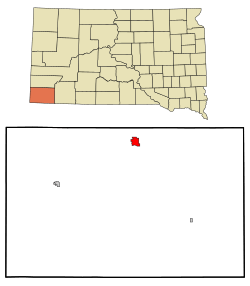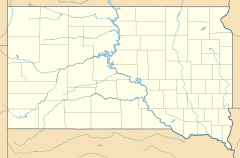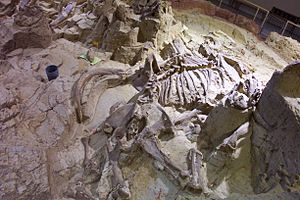Hot Springs, South Dakota facts for kids
Quick facts for kids
Hot Springs
Mni Kȟáta
|
|
|---|---|
| Hot Springs, South Dakota | |

Welcome Sign in Hot Springs
|
|
| Motto(s):
"Southern Gateway to the Black Hills"
|
|

Location in Fall River County and the state of South Dakota
|
|
| Country | |
| State | |
| County | Fall River |
| Incorporated | 1890 |
| Area | |
| • Total | 4.34 sq mi (11.24 km2) |
| • Land | 4.34 sq mi (11.24 km2) |
| • Water | 0.00 sq mi (0.00 km2) |
| Elevation | 3,448 ft (1,051 m) |
| Population
(2020)
|
|
| • Total | 3,395 |
| • Density | 806.91/sq mi (311.57/km2) |
| Time zone | UTC−7 (Mountain (MST)) |
| • Summer (DST) | UTC−6 (MDT) |
| ZIP Code |
57747
|
| Area code(s) | 605 |
| FIPS code | 46-30220 |
| GNIS feature ID | 1265256 |
Hot Springs (Lakota: mni kȟáta; "hot water") is a city in and county seat of Fall River County, South Dakota, United States. As of the 2020 census, the city population was 3,395. In addition, neighboring Oglala Lakota County contracts the duties of Auditor, Treasurer and Register of Deeds to the Fall River County authority in Hot Springs.
Contents
Overview
Hot Springs is one of the warmest places in South Dakota, with an annual mean temperature of 48.6 °F (9.2 °C). Some of the attractions in the Hot Springs area are the Mammoth Site of Hot Springs and Evans Plunge, built in 1890, with its naturally warm 87 °F (31 °C) spring water. The town is a gateway to the attractions of the southern Black Hills, particularly Wind Cave National Park. Hot Springs holds the annual Miss South Dakota pageant. In recognition of its historic value, the National Trust for Historic Preservation listed Hot Springs as one of its 2009 Dozen Distinctive Destinations.
The city center contains over 35 sandstone buildings. Hot Springs is also the home of a United States Department of Veterans Affairs hospital (Black Hills Healthcare System - Hot Springs Campus), which was designated in 2011 as a National Historic Landmark. Formerly known as the Battle Mountain Sanitarium, the 100-bed center was built in 1907 for patients suffering from rheumatism or tuberculosis. In the early 21st century, it offers extensive outpatient treatment, acute hospital care, PTSD treatment, and an alcohol and drug treatment facility.
The Battle Mountain Sanitarium was declared a National Treasure by the National Trust for Historic Preservation following a December 2011 proposal announced by the Department of Veterans Affairs to close the facility. Community and state leaders, including Senator Tim Johnson, Senator John Thune, and Representative Kristi Noem, opposed the closing. A concerned group of veterans and citizens organized a "Save the VA" Campaign; they have countered the VA's proposal based on the results of multiple Freedom of Information Act requests, getting as far as meeting with Secretary of Veterans Affairs Eric Shinseki to show how they believe VA leadership manipulated data to justify the proposed closure of the Landmark. After Veterans Health Administration scandal of 2014, Hot Springs was visited by members of the United States House Committee on Veterans' Affairs for a Congressional field hearing regarding the proposed closure and the committee heard testimony from members of Save the VA Committee and others opposed to the closure as well as two VA administrators in favor of the closure.
History
The Sioux and Cheyenne people had long frequented the area, appreciating its warm springs. According to several accounts, including a ledger art piece by the Oglala Lakota artist Amos Bad Heart Bull, Native Americans considered the springs sacred. European settlers arrived in the second half of the 19th century. They first named this city as Minnekahta; it was renamed in 1882. The present name is a translation of the Native American name. A variety of health resorts were built on the basis of the springs.
Geography and climate
Hot Springs is located at 43°26′N 103°29′W / 43.433°N 103.483°W (43.4311, -103.4776). The Fall River runs through the city.
According to the United States Census Bureau, the city has a total area of 3.61 square miles (9.35 km2), all of it land.
Hot Springs has been assigned the ZIP code 57747 and the FIPS place code 30220.
| Climate data for Hot Springs, South Dakota (1981–2010) | |||||||||||||
|---|---|---|---|---|---|---|---|---|---|---|---|---|---|
| Month | Jan | Feb | Mar | Apr | May | Jun | Jul | Aug | Sep | Oct | Nov | Dec | Year |
| Average high °F (°C) | 41.0 (5.0) |
44.0 (6.7) |
53.0 (11.7) |
61.9 (16.6) |
71.1 (21.7) |
80.5 (26.9) |
89.0 (31.7) |
88.2 (31.2) |
78.8 (26.0) |
65.0 (18.3) |
49.6 (9.8) |
39.7 (4.3) |
63.5 (17.5) |
| Average low °F (°C) | 14.4 (−9.8) |
16.1 (−8.8) |
23.8 (−4.6) |
31.8 (−0.1) |
42.0 (5.6) |
50.7 (10.4) |
57.3 (14.1) |
55.7 (13.2) |
45.1 (7.3) |
33.8 (1.0) |
22.9 (−5.1) |
13.9 (−10.1) |
33.9 (1.1) |
| Average precipitation inches (mm) | 0.35 (8.9) |
0.49 (12) |
1.05 (27) |
1.97 (50) |
3.13 (80) |
2.83 (72) |
2.39 (61) |
1.77 (45) |
1.43 (36) |
1.28 (33) |
0.50 (13) |
0.38 (9.7) |
17.56 (446) |
| Average snowfall inches (cm) | 4.5 (11) |
5.1 (13) |
7.3 (19) |
3.5 (8.9) |
0.4 (1.0) |
0.0 (0.0) |
0.0 (0.0) |
0.0 (0.0) |
0.1 (0.25) |
0.9 (2.3) |
3.6 (9.1) |
5.7 (14) |
31.0 (79) |
| Source: NOAA | |||||||||||||
Demographics
| Historical population | |||
|---|---|---|---|
| Census | Pop. | %± | |
| 1890 | 1,423 | — | |
| 1900 | 1,319 | −7.3% | |
| 1910 | 2,140 | 62.2% | |
| 1920 | 2,141 | 0.0% | |
| 1930 | 3,486 | 62.8% | |
| 1940 | 4,083 | 17.1% | |
| 1950 | 5,030 | 23.2% | |
| 1960 | 4,943 | −1.7% | |
| 1970 | 4,434 | −10.3% | |
| 1980 | 4,742 | 6.9% | |
| 1990 | 4,325 | −8.8% | |
| 2000 | 4,129 | −4.5% | |
| 2010 | 3,711 | −10.1% | |
| 2020 | 3,395 | −8.5% | |
| U.S. Decennial Census 2017 Estimate |
|||
2010 census
As of the census of 2010, there were 3,711 people, 1,730 households, and 910 families residing in the city. The population density was 1,028.0 inhabitants per square mile (396.9/km2). There were 1,958 housing units at an average density of 542.4 per square mile (209.4/km2). The racial makeup of the city was 85.4% White, 1.1% African American, 9.3% Native American, 0.5% Asian, 0.1% Pacific Islander, 0.2% from other races, and 3.5% from two or more races. Hispanic or Latino of any race were 2.1% of the population.
There were 1,730 households, of which 21.0% had children under the age of 18 living with them, 38.4% were married couples living together, 11.0% had a female householder with no husband present, 3.2% had a male householder with no wife present, and 47.4% were non-families. 42.9% of all households were made up of individuals, and 20.3% had someone living alone who was 65 years of age or older. The average household size was 2.03 and the average family size was 2.79.
The median age in the city was 49.8 years. 19.1% of residents were under the age of 18; 5.6% were between the ages of 18 and 24; 18.8% were from 25 to 44; 32.9% were from 45 to 64; and 23.7% were 65 years of age or older. The gender makeup of the city was 50.4% male and 49.6% female.
Notable people
- Albert R. Anderson, U.S. Representative, mayor of Lead, and lawyer
- Joseph Bottum, writer
- Jacob Christensen, American YouTuber
- Dan Dryden, educator and politician
- Charles S. Eastman, attorney and member of the South Dakota House of Representatives
- Jarrod Emick, musical theatre actor
- Orlando Ferguson, proponent of the Flat Earth Theory
- Charles Hargens, painter
- Leslie Jensen, 15th Governor of South Dakota
- Jacqueline Left Hand Bull, Continental Counselor and Chair of the National Spiritual Assembly of the Bahá'ís of the United States
- Jess Thomas, American operatic tenor
Images for kids
See also
 In Spanish: Hot Springs (Dakota del Sur) para niños
In Spanish: Hot Springs (Dakota del Sur) para niños






